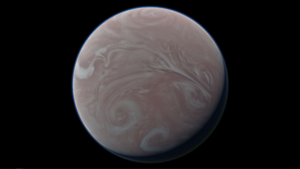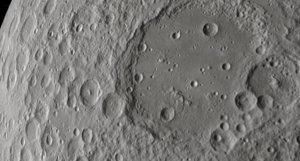Celestia facts for kids
 |
|

|
|
| Original author(s) | Chris Laurel |
|---|---|
| Developer(s) | Celestia Development Team |
| Initial release | 26 February 2001 |
| Stable release |
1.6.4 / 5 November 2023
|
| Written in | C++ |
| Operating system | AmigaOS 4, BSD, Linux, macOS, Microsoft Windows, iOS, Android, FreeBSD |
| Size | Linux: 27.7 MB AmigaOS 4: 44.4 MB macOS: 38.7 MB Windows: 32.8 MB FreeBSD: 65.7 MB Source code: 52.6 MB |
| Available in | 31 languages |
| Type | Educational software |
| License | GPLv2 |
Celestia is a cool computer program that lets you explore space in 3D! It's like having your own spaceship to travel through the universe. You can see planets, stars, and even galaxies. Chris Laurel created Celestia in 2001.
Unlike other planetarium programs that only show you the sky from Earth, Celestia lets you go anywhere. You can fly around planets, visit distant stars, or even zoom through entire galaxies. It uses special computer graphics called OpenGL to show everything in amazing detail.
Celestia is free to download and use. It works on many different computers and devices, including Linux, macOS, Microsoft Windows, and even mobile phones like iOS and Android.
The original development of Celestia paused in 2013. However, a new team started working on it again in late 2016. They have been making updates and improvements. In 2020, Celestia became available on mobile devices. In 2024, it was even made available for the Apple Vision Pro. You can download Celestia from its official website or other free software sites. Millions of people have downloaded it over the years!
Contents
What Celestia Can Do
Celestia shows you a huge number of stars. The latest versions include over 2 million stars, using data from real space catalogs like Hipparcos and Gaia. It also shows the paths of planets, dwarf planets, moons, asteroids, comets, and even satellites. You can see how they move around in space.
You can display the names of space objects, like planets or artificial satellites. You can also see names of places on Earth, such as continents, mountains, and cities. On other planets and moons, you can see features like craters and canyons.
Celestia lets you move at different speeds, from very slow to super fast. You can orbit around stars or planets, follow spacecraft as they fly, or even travel to distant galaxies. The program can also show you how light travels, so you see things as they would appear from far away.
You can set the time in Celestia to almost any point in the past or future. You can go back or forward 2 billion years! However, the paths of planets are most accurate for times close to today.
Celestia also makes planets and moons look realistic. It shows atmospheres, how light from a planet shines on its moons, and beautiful sunrises and sunsets. You can also get information about objects, like their temperature, size, and how far away they are.
You can change how much of space you see on your screen. You can even split the screen to look at several objects at once. Celestia also lets you take pictures and record videos of your space journeys.
Celestia can be made even better with "add-ons." These are extra files created by users that add new objects or features. Add-ons can include new planets, spacecraft, or even entire fictional universes. Celestia also uses special scripts that let you run different commands and create amazing tours.
Things Celestia Doesn't Do Perfectly
Celestia has some limitations, but many can be fixed with add-ons.
- Earth's Shape: By default, Celestia shows Earth as a perfect sphere. Because Earth's surface is actually bumpy, satellites in low orbit might not appear in exactly the right spot when viewed from the surface.
- Missing Objects: Some types of space objects, like variable stars (stars that change brightness), black holes, and nebulae (giant clouds of gas and dust), are not included in the basic program. But you can often find them as add-ons!
- Star Movement: While planets and moons move, and stars rotate, Celestia doesn't show how stars slowly move across the sky over thousands of years. Also, galaxies stay in fixed spots. This means constellations in Celestia don't change shape over time like they do in real life.
- Distant Objects: Celestia doesn't show stars that are extremely far away in older versions. However, newer versions include stars much further out, even near the center of our galaxy. There's also a limit to how far away stars and objects in star systems will appear.
- Light and Color: Celestia tries to show space as humans would see it. It doesn't show special views like false-color maps or camera effects like lens flare.
- Gravity: Celestia doesn't simulate gravity itself. So, if an asteroid is heading towards Earth, Celestia won't show it bending its path due to Earth's gravity unless that effect was already put into the asteroid's path data.
- Shadows: Some small or oddly shaped moons don't cast shadows on their planets during eclipses. This is something the developers are working on for future versions.
- Spacecraft Models: Many real-world spacecraft, like Voyager 2, are not included in the basic Celestia program. The ones that are included might have older, less detailed models. Luckily, many users create amazing add-ons with high-quality, updated models.
- Time Limits: Celestia uses the Julian calendar and can't go further than 2 billion years into the past or future. Also, the default time system works best for years between -9999 and 9999.
Add-ons: Expanding Your Universe
One of the best things about Celestia is its huge collection of add-ons! These are extra files created by a large community of users. There are over 80 gigabytes of add-ons available, which is a lot of extra content!
These add-ons can include:
- Better Textures: Higher-quality surface maps for planets and moons, making them look even more realistic when you zoom in close.
- Spacecraft: Detailed 3D models of real spacecraft, like Sputnik 1, the Hubble Space Telescope, and the International Space Station, flying on their actual paths.
- More Objects: Extended catalogs of stars, DSOs (like nebulae and galaxies), asteroids, and comets. You can even see over 96,000 locations on Earth.
- Special Objects: Models of different types of stars (like red giants or black holes), spinning pulsars, and even animated solar flares.
- Historical Events: Recreations of famous space missions or meteor impacts, like the Chelyabinsk meteor.
Many scripts are also available. These can be simple tours of the Solar System, detailed recreations of complex space missions like Cassini–Huygens, or educational scripts showing how stars evolve.
You can even explore fictional universes! Add-ons exist for worlds from movies like 2001: A Space Odyssey, Star Trek, and Star Wars. There are also add-ons for fictional planetary systems created by other Celestia users.
Educational add-ons are also popular. These can offer hours of space journeys and astronomy lessons. They cover topics like the life cycle of stars, the human space program, and even ideas like the possible terraforming of Mars in the future.
Some big add-on projects aim to make Celestia even more stunning. For example, "Celestia Origin" replaces all the original graphics with higher-quality ones and adds many more objects. Another project, "Project Echoes," also focuses on better textures, and the new Celestia 1.7.0 version seems to be inspired by it.
See also
 In Spanish: Celestia para niños
In Spanish: Celestia para niños
- Gravity (software)
- OpenUniverse
- Orbiter (simulator)
- Planetarium software
- SpaceEngine
- Space flight simulation game
- List of space flight simulation games
- List of observatory software







